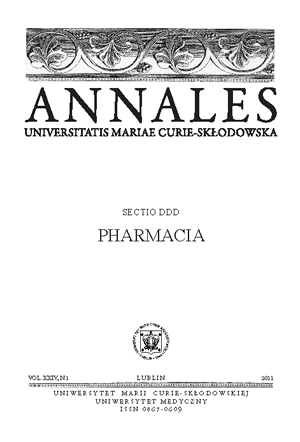Olejek eteryczny z owoców Angelica officinalis i jego aktywność przeciwbakteryjna
Słowa kluczowe:
Angelica officinalis, olejek eteryczny, aktywność przeciwbakteryjna, GC-MSAbstrakt
Olejek eteryczny otrzymany przez destylację z parą wodną owoców Angelica officinalis, zebranych w ogrodzie botanicznym w Polsce, poddano analizie metodą GC-MS. Zidentyfikowano 30 składników olejku, spośród których dominującym był β-felandren (73%). Stosując metodę mikrorozcieńczeń w podłożu bulionowym oznaczono najmniejsze stężenie olejku hamujące namnażanie bakterii (MIC), a następnie najmniejsze stężenie bakteriobójcze (MBC). Badany olejek eteryczny wykazał umiarkowane działanie przeciwbakteryjne w kierunku testowanych szczepów. Zauważono niewielką różnicę w sile działania wobec bakterii Gram-dodatnich i Gram-ujemnych – zakres wartości MIC odpowiednio 0.62 do 1.25 mg/ml oraz 1.25 do 2.5 mg/ml.
Bibliografia
1. Adams R.P.: Identification of Essential Oil Components by Gas Chromatography/Mass Spectroscopy’ Allured Publishing Corp., Carol Stream, IL, USA 2001.
2. Bernard C.: Essential oils of three Angelica L. species growing in France. Part II: Fruit oils. J. Essent. Oil, 13, 260, 2001.
3. Bogucka-Kocka A., Smolarz H.D., Kocki J.: Apoptotic activities of ethanol extracts from some Apiaceae on human leukaemia cell lines. Fitoterapia, 79, 487, 2008.
4. Burt S.: Essential oils: their antibacterial properties and potential applications in foods—a review. Intern. J. Food Microbiol., 94, 223, 2004.
5. Glowniak K., Gawron A., Kwietniewska B.: Investigations on coumarins of Archangelica officinalis Hoffm. Fruits.: Annales UMCS Sect. D Medicina, 31, 349, 1976.
6. Holm Y., Vuorela P., Hiltunen R.: Enantiomeric composition of monoterpene hydrocarbons in n-hexane extracts of Angelica archangelica L. roots and seeds. Flav. Frag. J., 12, 397, 1997.
7. Howes M.R., Perry S.L., Houghton P.J.: Plants with traditional uses and activities, relevant to the management of Alzheimer's disease and other cognitive disorders. Phytother. Res., 17, 1, 2003.
8. Lopes D., Strobl H., Kolodziejczyk P.: 14-Methylpentadecano-15-lactone (muscolide): a new macrocyclic lactone from the oil of Angelica archangelica L. Chem. Biodiver., 1, 1880, 2004.
9. Luszczki J.J., Głowniak K., Czuczwar S.J.: Imperatorin enhances the protective activity of conventional antileptic drugs against maximal electroshock-induced seizures in mice. Eur. J. Pharmacol., 574, 133, 2007.
10. Luszczki J.J., Głowniak K., Czuczwar S.J.: Time-course and dose-response relationships of imperatorin in the mouse maximal electroshock seizure threshold model. Neurosci. Res., 59, 18, 2007.
11. Muller M. et al.: 2D NMR spectroscopic analyses of archangelicin from the seeds of Angelica archangelica. Acta Pharm., 54, 277, 2004.
12. Nivinskiene O., Butkiene R., Mockute D.: The seed (fruit) essential oils of Angelica archangelica L. growing wild in Lithuania. J. Essent. Oil, 19, 477, 2007.
13. Polish Pharmacopoea VI, Polish Pharmaceutical Society, Warsaw 2002.
14. Roos G. et al.: Isolation, identification and screening for COX-1- and 5-LO-inhibition of coumarins from Angelica archangelica. Pharm. Pharmacol. Lett., 7, 157, 1997.
15. Sarker S.D., Nahar L.: Natural Medicine: The Genus Angelica. Curr. Med. Chem., 11, 1479, 2004.
16. Schelz Z., Molnar J., Hohmann J.: Antimicrobial and antiplasmid activities of essential oils. Fitoterapia, 77, 279, 2006.
17. Sigurdsson S., Ögmundsdottir H.M., Gudbjarnason S.: The cytotoxic effect of two chemotypes of essential oils from the fruits of Angelica archangelica L. Anticancer Res., 25, 1877, 2005.
18. Skalicka-Woźniak K. et al.: Antimicrobial activity of fatty acids from fruits of Peucedanum cervaria and P. alsaticum. Chem. Biodiv., 7, 2748, 2010.
19. Skalicka-Woźniak K. et al.: Comparison of hydrodistillation and headspace solid-phase microextraction techniques for antibacterial volatile compounds from the fruits of Seseli libanotis. Nat. Prod. Commun., 5, 1427, 2010.
20. Tutin T.G. et al.: Flora Europaea, Rosaceae to Umbelliferae. Cambridge Univeristy Press, II, 1968, page 357.
21. Waksmundzka–Hajnos M. et al: Effect of extraction method on the yield of furanocoumarins from fruits of Archangelica officinalis Hoffm. Phytochem. Anal., 15, 1, 2004.
Pobrania
Opublikowane
Numer
Dział
Licencja
Prawa autorskie (c) 2011 Autorzy

Praca jest udostępniana na licencji Creative Commons Attribution-NonCommercial-NoDerivatives 3.0 Unported License.


